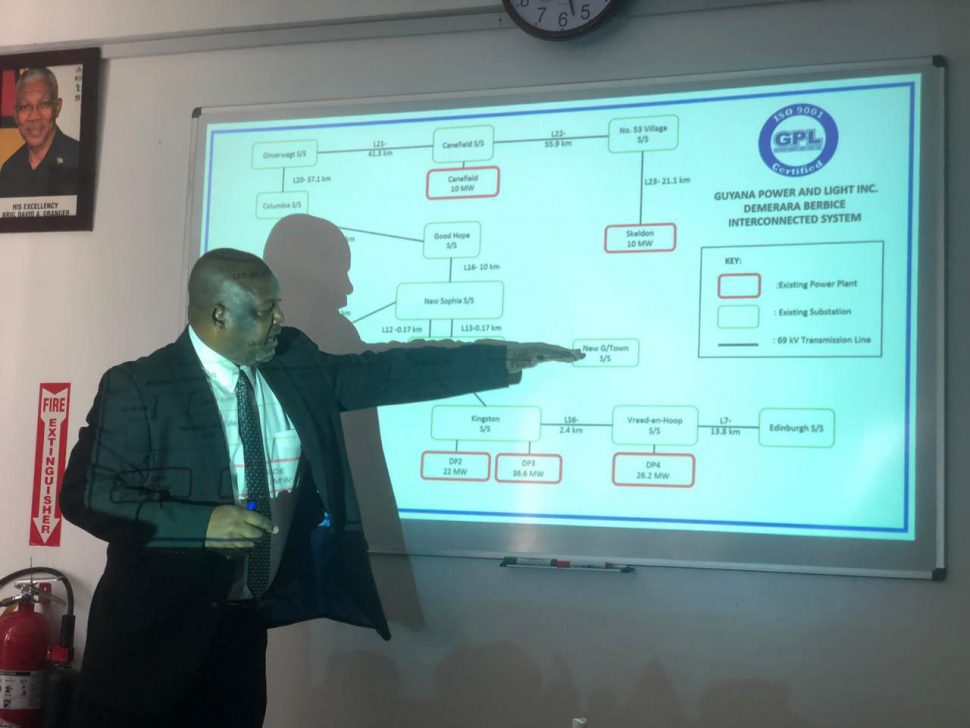With the Guyana Power and Light Inc.’s (GPL) submarine cable expected to take more than two weeks to be repaired, the Chief Executive Officer (CEO) of the power company says they are putting emergency plans in place to reduce the frequency of blackouts.
GPL’s CEO Albert Gordon, related such at a press conference yesterday morning at the company’s corporate headquarters on Duke Street, after their submarine cable was damaged on Sunday. The damage has resulted in long hours of scheduled blackouts across the country.
The emergency works include running a submarine cable from Vreed-en-Hoop to Kingston to bring additional power, conducting overhaul maintenance to one of the Kingston generating units, and replacing a defective alternator.
Gordon said that they had reached out for alternatives for fixing the cable but had to resort to the company, China National Machinery Import and Export Corporation (CMC), to carry out the works quickly.
“We are pushing them but it will take a few weeks and we are trying not to go past a month, but they have to do mobilisation and all kinds of things,” Gordon said, while noting that in the meantime, they have various plans to ensure that the frequency of blackouts decrease.
According to the company’s Divisional Director of Operations, Bharat Harjohn, the cable developed a fault on Sunday night around 7:21 pm, which they suspect was caused by the anchor of a vessel. He said their distance relay detected that the fault was around 714 metres from the Kingston Substation and 1.1 km from the Vreed-en-Hoop Substation.
Since then, preliminary works have commenced with CMC and they are currently on the ground with their divers inspecting the cable, which has since shown damage to its aluminum casing.
A press release yesterday afternoon noted that upon examination of the cable, the armour and insulation protection of the cable bore damage which extended to the conductors within the cable.
Further examination along the remaining length of the cable that lies within the channel of the Demerara River extending to Vreed-en-Hoop, will be conducted today.
However, because of the damage, they have lost a total of 14 MW of power that they import from the Vreed-en-Hoop Power station. As of now, the eastern side of the Demerara-Berbice Interconnected System (DBIS) has a capacity of approximately 90 MW of power available to satisfy a demand of 100 MW across the grid.
As a result, a 10 MW shortfall has been created which has resulted in load shedding activities across the country.
In addition to the cable, Harjohn said that their woes were compounded after their second and third largest generating units, which contribute 7.8 and 6.9 MW respectively to the Kingston 2 plant, went down. The units are currently under maintenance. This occurrence will likely raise questions about the efficient maintenance of these units.
The 7.8 MW unit is scheduled for overhaul maintenance and is expected to be back operating by next Wednesday, while the other unit is down because of a defective alternator, which is expected to arrive in the country from Miami next week.
“What we are doing presently to help with this shortfall is we have returned two units from Anna Regina that would’ve been moved from Canefield and are now bringing it back to restore 2 MW of power,” Harjohn said.
He added that they will also be running a 13.8 KV submarine cable (as opposed to a larger 69 KV cable) from Vreed-en-Hoop to Kingston to assist with bringing at least 6 MW of power, and are hoping to have that completed within a week and a half, as works have already commenced and persons are on the location assessing the area to see how fast they can get it done.
While they were not able to say how much the cable would cost to repair, Divisional Director of Projects, Ryon Ross, said that they would first have to look at the extent of the damage, something they have not done as yet, and only then they would be able to attach a cost for the repairs, which he said also encompasses other accompanying costs.
However, he did note that it is a significant undertaking for the power company.
“This is not the first time the 69 kV cable has been damaged. It is well known that this cable has been laid in a commercial shipping zone, hence, there is a likelihood of ships anchoring and damaging the cable,” Ross said.
In order to prevent such an incident from recurring, Ross said that they will be working along with the Maritime Administration Department (MARAD) to see what measures they can put in place to monitor the area and also notify vessels of the location of the cable.
“In the meantime, we are doing all we can to get the power over…when we get that 6 MW and 7.8 MW back and we are bringing the units that we brought over from Anna Regina and it’s small but it can make a difference. We are looking at other options as well which may take a little longer,” Gordon said, while noting that once their emergency plans are in place, the situation with scheduled blackouts and load shedding should be significantly improved.






